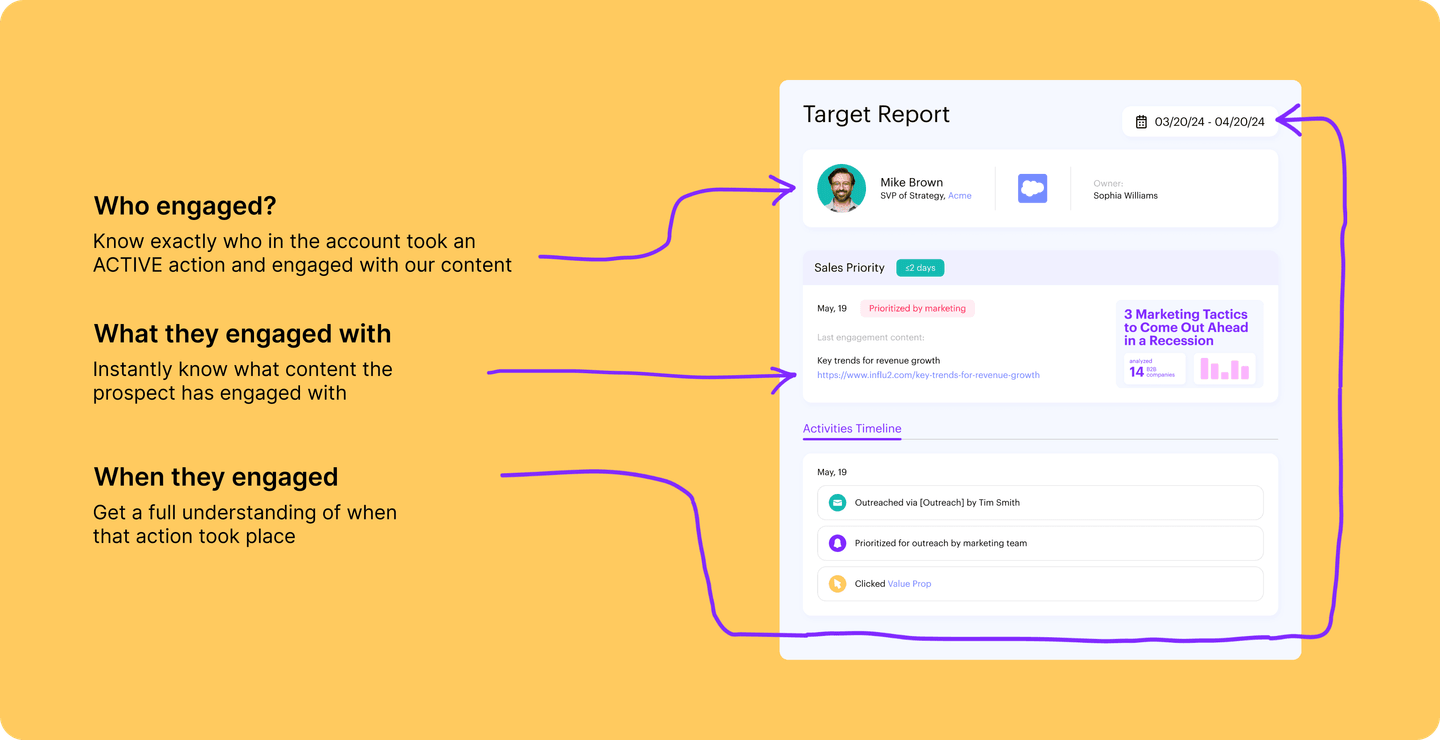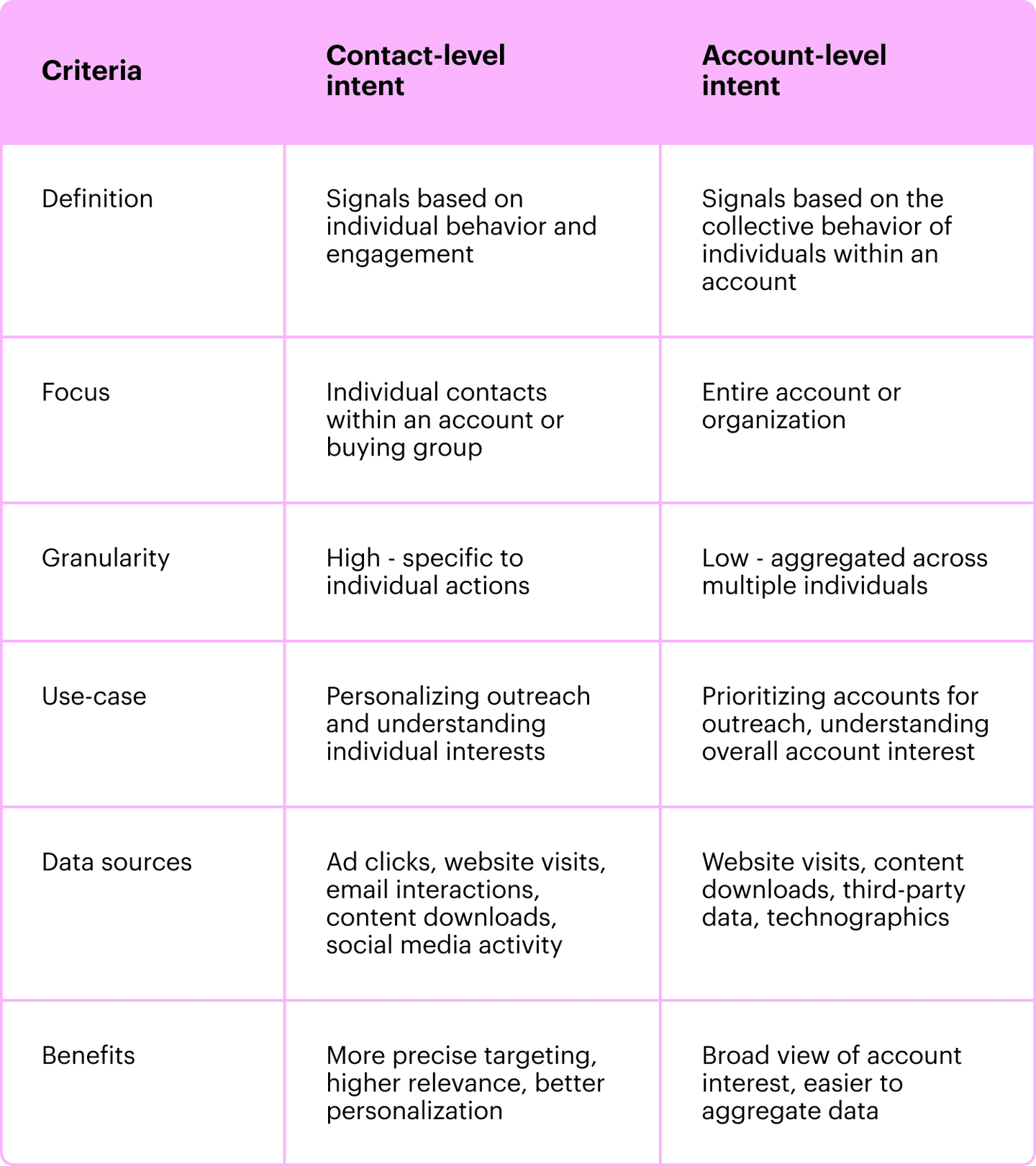Account Level vs. Contact Level Intent Signals: How to Understand Prospects' Needs

Account-level intent signals can tell you which companies may be interested in topics related to your product, but they don’t reveal the intricate web of influence within the account or buying group.
On the flip side, contact-level intent helps marketers and salespeople understand and engage with specific influencers, champions, and decision-makers within an account.
Here’s an in-depth comparison of contact and account-level intent signals, and when to use each based on your goals.
What’s the difference between account-level and contact-level intent signals?
Account-level intent signals are the collective behavior of individuals within an account that indicate they may be interested in what you’re selling.
These signals are often collected from third-party data sources and made available from account-based marketing tools.
For instance, an ABM tool could show you that employees at Microsoft are searching for keywords relevant to your business or browsing your product category on review sites.
The problem is you don’t know specifically who at Microsoft is doing the research. It could be a high-level decision-maker actively shopping, or a junior-level employee casually browsing.
This is where contact-level intent has a significant advantage.
Contact-level intent is an indication or signal that a specific person within a target account has shown interest in a product or service.
Instead of “people at Microsoft are searching topic XYZ”, contact-level intent signals tell you “Bob, Head of Demand Generation clicked on your ad about XYZ on December 2nd.”

Breadth vs depth
Since contact-level intent gives you significantly more context, you might wonder why account-level intent is so commonplace.
The main use case for account-level intent signals is if you need help identifying target accounts.
Your product might be a good fit for thousands of companies, but that doesn’t mean they’re all interested in buying it. Account-level intent signals can help narrow your list to companies that have shown interest in topics related to your product.
Contact level intent gives you depth.
Once you know the companies you want to target, you need to know the specific people involved in the buying process (i.e. the buying group) and understand their needs.
For a more detailed look at how contact-level intent works, read this guide: Contact-Level Intent: How to Uncover Prospect Pain Points & Boost Conversions.
And here’s a quick side-by-side comparison of contact level versus account level intent:

5 things you can do with contact-level intent signals that you can’t with account-level signals
Account-level intent signals have their place, but they’re likely limiting the effectiveness of your campaigns.
Here are five valuable things you can do with contact-level intent that you miss out on with account-level intent signals.
1. Know who to reach out to
One of the biggest struggles of account-level intent signals is figuring out who you need to reach out to.
I recently listened to a chat from the SDR Leader community that highlighted how account-level intent signals can actually create friction between marketing and sales.
Don’t let that become your reality.
Here’s how to give your sales team the data they need so you can avoid fracturing the relationship.
With contact-level intent, you can show ads to the exact prospects your salespeople want to reach and track who clicked which ad.
When the intent signal happens, you know exactly who it came from and can provide that context to your sales team.
2. Address individual pain points
By definition, account-level intent signals force you to use broad messaging.
Everything from your marketing campaigns to sales outreach has to be high-level because you don’t know which pain points to address for each prospect within an account.
However, that’s the exact opposite of what consumers want.
According to a Forrester report conducted for Adobe, 57% of B2B customers expect personalized content when discovering a company’s products or services and 59% when researching or exploring them.
If you don’t address the pain points that matter most to your prospects, you might be inadvertently sabotaging your campaigns and pipeline.
Contact-level intent can give you the data you need to address the pain points of individual prospects.
For instance, imagine you want to target a large company for your social media marketing software.
Each person within the buying group likely has a list of pain points your product can address, but you need to identify which pain points resonate most with each prospect.
Using Influ2, marketers can show ads promoting their top value propositions to each prospect within a buying group.
When a prospect clicks an ad, that creates an intent signal.
Based on what each prospect clicks, you know what value proposition resonates with them and can give them more content relevant to their pain point and salespeople can use that value proposition in their outreach.

3. More accurately gauge buyer readiness
Account-level intent signals show broad interest. They don’t tell you how far along in the buying process a target is or even specifically who the signals came from.
This creates a challenge for marketers and salespeople:
- Marketers don’t know whether to serve top, middle, or bottom-of-funnel messaging and content
- Salespeople don’t know which prospects in a target account to prioritize, or each prospect’s level of interest
With contact-level intent signals, you know exactly who each buying intent signal came from, so you can gauge each prospect’s readiness to buy throughout the buying journey.
Here’s an example of what the process looks like with Influ2.
With Influ2, marketers can create ad campaigns targeting specific people within a buying group, and tailor ads to each stage of your buyers' journey.
As prospects engage with ads and move through the buyer journey, you’ll have a better understanding of how ready they are to buy.
For example, if Prospect A hasn’t clicked on any ads, while Prospect B clicked on an ad to schedule a demo and subsequently clicked another ad for a customer case study, they’re signaling they’re more ready to buy than Prospect A.
This context also makes it easier for salespeople to prioritize who to contact first. It would make more sense for salespeople to focus their efforts on Prospect B than Prospect A, since they’re further along in the buying journey.
That’s a simplified example. To learn more, check out this playbook: 15 ABM Campaign Examples to Personalize Every Stage of the Buyer’s Journey
4. Create behavior-based triggers
You can use contact-level intent to inform your next best action from Sales and Marketing.
For instance, if a target prospect clicks an ad highlighting one of your value propositions, a salesperson should contact them with a message related to that specific value proposition.
Once the salesperson contacts the prospect, Marketing can start showing different ads to that prospect that further emphasize the value proposition they engaged with.
This not only gives your prospect a more meaningful and logical buying experience, but also makes it easier for Sales and Marketing to work together.
Think of each new intent signal as an additional data point for Sales and Marketing to optimize each prospect’s buying journey.
5. Be proactive instead of reactive
A major downside of account-level intent signals is it forces you to be reactive.
First, you have to wait until a potential prospect decides to do research. Then you wait for your ABM tool to give you insights from third-party data like “a marketer from Tesla searched XYZ topic.”
At that point, you still don’t know who the prospect is, what their product-specific pain points are, or if they’re even in the market.
With Influ2, you can proactively create first-party buying intent signals for prospects your salespeople are actively pursuing.
When your sales team identifies which prospects they’re targeting, you can start showing them ads to create buying intent signals, instead of waiting for them to discover you.
Each time someone engages with an ad, you see exactly who engaged with which ad and when.
Focus on contact-level intent signals for more successful campaigns
Account-level intent signals have their place, but they’re limited in terms of the value they provide salespeople and marketers.
Contact-level intent gives you context and actionable insights to convert prospects. If you’re interested in learning about how to create and use contact-level intent signals to improve your campaigns, let’s talk.






